- Know
about the handloom products of Jammu and Kashmir.
The textile
tradition in Kashmir has a glorious history of the world-renowned tapestry that
is very popular. May it be Kani shawls or Amlikar needlework, even today the
hand-woven textile products are a speciality of the many Kashmiris skilled
weavers.
A little
history first
In Kashmir, the
earliest records of tapestry designs go back as far as the seventh century. In
the sixteenth century Mughal period, however, there was a boom in the
popularity of Kashmiri shawls in the country. Primarily worn by Kings and royal
courtiers, the uniquely gifted work of many weavers found its ways beyond the
Indian Sub-continent during this period. It was only in the mid-1800s, that
Kashmiri shawls became popular among the European elite mainly the French. In
the late eighteenth century, the industrial age appeared, which bestowed a
certain global acknowledgement of this art-form.
The fabric
behind a great shawl
The shawls which
are known for their inimitable tapestry design use a fibre known as Pashm or
Pashmina. The fibre normally comes from the fleece of a wild Cashmere Asian
Mountain goat known by its scientific name as Capra hircus.
The goat sheds its wool in the early days of June
as the summer approaches. Shawl-maker usually gathers this wool which is
characterised by its exclusive properties, to make a good Pashmina shawl. The
fibre is only 15 micron in thickness along with being extremely regular in
structure, making it a perfect fibre for ‘fine spinning’. Many sources of fibre are mixed
to augment the quantity of the raw material making the Pashmina
shawls unique by way of it being soft, silky and warmer than others.
Kani Shawls
or Jamawar
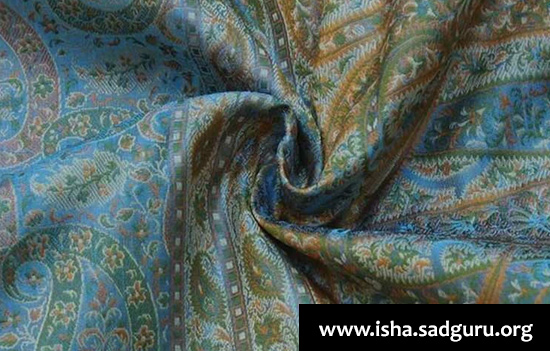
Credits
and read
The beautiful
tapestry among the Kashmiri textile is more evident in its most popular
version. The Kani shawls are made from special ‘Kani needle’ as each shawl
takes around a year or two to be done by the traditional method. This is a
tradition that was revived in post-independent India and is identified by its
characteristic intricately woven designs. These pashmina figure-shawls are
composed of discontinuous coloured weft interlocked within each other. These
gorgeous looking shawls are entirely made of wool, however, in some instances,
a little cotton is added. The motifs are a beautiful imitation of nature
displaying flowering plants with vivid colours.
Amlikar
shawl
The Amlikar or
Amil needlework is another speciality of Kashmiri artwork, as these shawls are
filled with rich colours and beautiful motifs of flowers. Made entirely of Pashmina
wool, the needlework is only one to have an embroidery stitch parallel to the
darning stitch, made possible by some of the divinely skilled rafoogars
(darners). These are so delicately woven that the needle never really penetrates
the entire fabric during the entire making of a particular shawl.
Dourukha
shawls
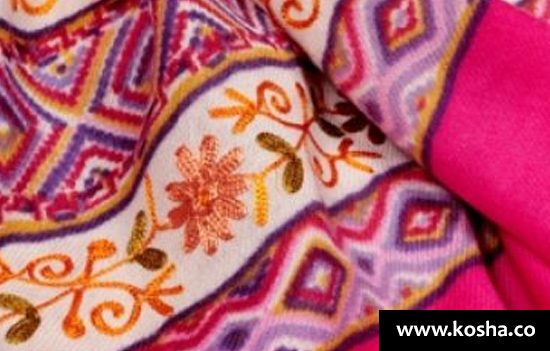
Reference
and credits
This is a type of
woven shawl which you should look out for. With its multi-coloured pattern, the
dark coloured outlines highlight its contrast with the rest of the shawl. But
the thing that makes it more unique is that the artisan achieves the same
effect on both sides of the shawl.
Kashmiri
shawl motifs
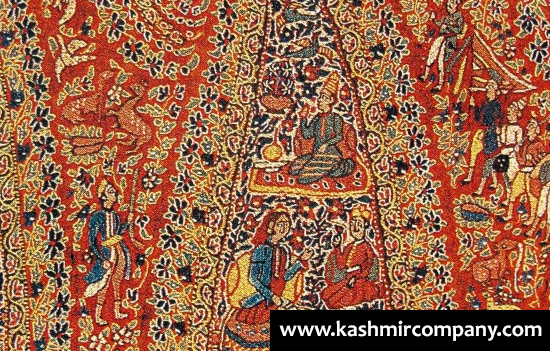
Credits
and good read
From early simple
designs to the intricate motifs that are seen today, Kashmiri shawls display an
ancient art of a fascinating nature.
There are a few
basic characteristics you can identify with Kashmiri embroidery. The formative
imitation of natural beauty that a Kashmiri motif may display includes the
depiction of flowers, leaves enriched with diverse colours, such as yellow,
white, black, blue, green, purple, crimson and scarlet.
Brilliantly
crafted embroidery flows smoothly with the surface of a shawl and the rich
colours together become an integral part of the entire fabric. The contrast
among the different part of a shawl mainly the gallery and field are what draws
our eyes in.
Kashmiri Pashmina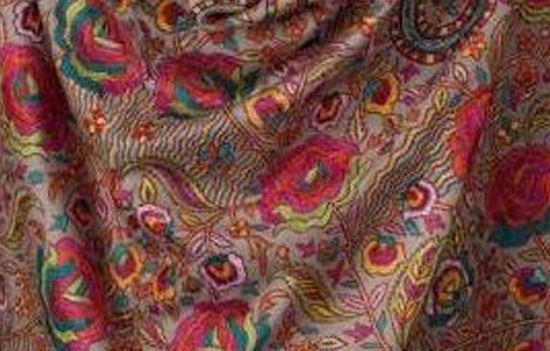
Pashmina is synonymous with Kashmir;
hence was called ‘cashmere’ when it spread to the west. A luxury fabric woven
in the region since decades, Kashmiri Pashmina is a combination of
both material and traditional process. Developed and refined by Kashmiri
artisans to make the fabric incredibly light with strength and lustre, this
process is believed to retain the uniqueness of Pashm - the reason why bona
fide Pashmina cannot be woven on machines.
A
morning at the master weaver’s studio gives an understanding of the process of
Pashmina weaving from the fibres of Pashm that is 1/10th the width of human
hair, to spinning gossamer-like yarns and weaving fine fabrics.
The
editor found Pashmina shawls being woven in village Darkot near Munisyari,
Uttarakhand. The weaver said they get Pashmini fibre from Tibet. To see album
CarpetsCarpet weaving
in Kashmir in India arrived with the Mughals. The craft flourished in Kashmir
and the place has today become a hub for quality rugs.
The
patterns are influenced by the Persian style blended with Indian designs. One
typical Kashmiri Indian pattern is the tree of life. While most carpet weaving
has shifted to the countryside, carpet workshops can be spotted in the heart of
Srinagar, where weavers knot 900 times in a square inch. Fine silk and wool
carpet weaving, introduced by the Persians during the 14th century, has
flourished in Kashmir since the Mughal times and is still among the most
expensive in the world. Traditional Persian designs and motifs are hand knotted
on a simple vertical loom, reciting a ‘talim’, the written design script of
instructions. The designs are still named after famous Persian cities, such as
Kashan and Hamdaan.
A
good article
on Carpet-making in Kashmir
The
Editor found excellent carpets at the Tawang Craft Centre (Arunachal Pradesh).
To see album
Namdahs
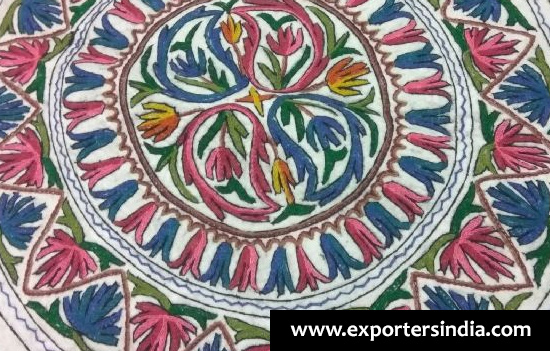
Credits
Far
less expensive than the carpets are the Namdahs, which are excellent and
vibrant floor coverings for winters, made by felting together layers of wool
and cotton fibre and manually pressed into shape. Prices vary with the
percentage of wool - a Namdah containing 80 per cent wool being more expensive
than the one containing 20 per cent wool. Chain stitch embroidery in woollen
and cotton thread is worked on these rugs. A specialty of Yarkand during the
Mughal times, the Kashmiri embroidered Namdahs became renowned in the last
century and it is fascinating to actually see this unique felting process being
done by foot even today in the old part of the city.
Pherans
This garment, somewhere between a coat and a cloak, is eminently suited to the Kashmiri style of life, being loose enough to admit the inevitable brazier of live coals which is carried around in much the same way as a hot water bottle. Men's pherans are always made of tweed or coarse wool; women's pherans, somewhat more stylized, are most commonly made of raffel, with splashes of Aari or hook embroidery at the throat, cuffs and edges. The quality of embroidery and thickness of the raffel determines the price.
Sozni Embroidery

Credits
A
craft introduced by mystics, Sozni is the needle embroidery with a
unique darning stitch and is considered a meditative practice even today to
immerse oneself in the divine.
The master embroider works with a single strand of silk on Pashmina and spends
years in embellishing each Jamavaar shawl with intricate designs and motifs.
The
mystical
almond buteh, the signature motif for all fine Kashmiri shawls, later became
the ‘paisley’ after its imitations were produced in England.
Tilla Embroidery

Credits
The Tilla embroidery with yarns of gold and silver zari is another
distinct ornamentation on pherans and shawls, the best of them being found
around Zaina Kadal and a must in every Kashmiri girl’s trousseau. The gold yarn
called Tilla is arranged in intricate swirls and held down with minute stitches
like a couching stitch.
Shahtoosh Shawls
Shahtoosh shawls are
made from the wool of the Tibetan antelope. These shawls are very light and
soft. They are extremely expensive because the wool used in making these shawls
is scarce. The soft hair from the throat of the antelope is used for making these
shawls. A few of this hair fall off naturally when the antelopes graze. They
are collected and are then used in weaving shawls.
Shahtoosh shawls may
either be pure or mixed with Pashmina in order to reduce the cost. The
specialty is that they are so finely woven that the entire shawl can pass
through a ring. It is for this reason that such shawls are known as ‘Ring
shawls’. They are usually not dyed and are used in their natural color i.e.
light brown.
Kashmiri silk
Like Kashmiri tweed,
Kashmiri silk is also famous. Weaving and printing of silk are generally
not undertaken in Kashmir. However, cocoon rearing is undertaken on a large
scale here, which yields the best quality of silk. Rearing cocoons is one of
the major occupations of the people of Kashmir.
Kashmiri embroidery or (Kasida)
Locally known as
Kasida, the designs used in this embroidery are inspired by the natural beauty
of the Valley. Landscape designs, Chinar leaves as well as mythological figures
are commonly used in Kasida embroidery. Usually, such embroidery is done on
woolen or cotton cloth. Embroidered shawls are now being styled as stoles.
Pheran
Pheran is the
prominent attire for Kashmiri women. Pheran usually has Zari embroidery on the
hemline, around pockets, and mostly around the collar area. Ladies prefer suit
and Burkha during summers and Pheran during autumn. The headdress of a Kashmiri
woman is a brightly colored scarf or Tarang which is stitched to a suspended
cap with a cloth around it which extends down towards the heels. The Tarang is
an integral part of the wedding attire among Hindus.
Kashmiri
Pherans and Silk images
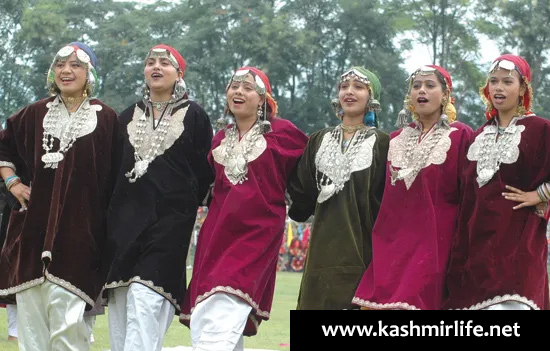
Credits
Saree-printed Kashmiri silk
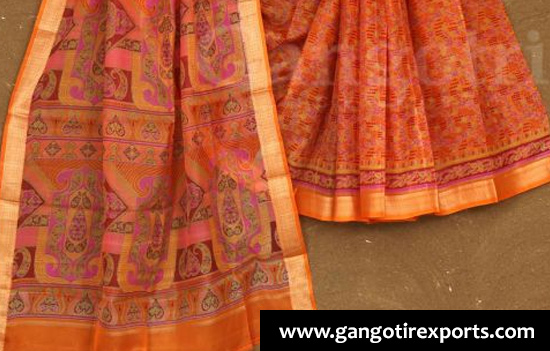
Credits
Kashmiri
embroidery on Shawls
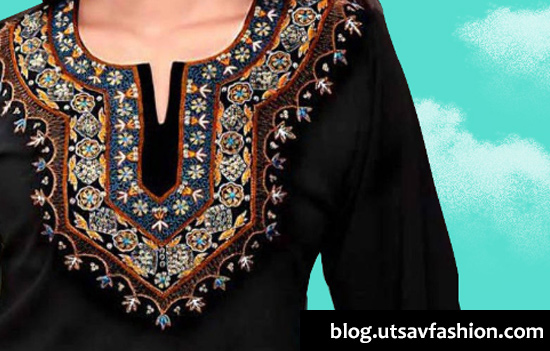
Credits
Amlikar shawl
The Amlikar or
Amil needle work is another speciality of Kashmiri artwork, as these shawls are
filled with rich colours and motifs of flowers. Made entirely with the Pashmina
wool, the needle work is the only one to have an embroidery stitch parallel to the
darning stitch, made possible by some divinely skilled rafoogars (darners). These are so delicately woven that the needle
never really penetrates the entire fabric during the entire making of a shawl.
Dourukha
shawls
This is a type of
woven shawl which you should look out for. With its multi coloured pattern, the
dark coloured outlines highlight its contrast with the rest of the shawl. But
the thing that make it more unique is that the artisan achieves the same effect
on the both sides of the shawl.
The
purpose of this compilation is to document and promote. We have given credits
and reference links in this compilation along with third party links (to
promote). In case some are missed, it is not with malafide intent. Please
email full details to esamskriti108@gmail.com
and we shall effect the change.
To read all
articles by author
To
read all articles on Traditional Textiles of India
Author Trishna
Patnaik
is a self-taught artist based in Mumbai, Trishna has been practising art for over 14 years. She is now a full-time professional painter pursuing her passion to create and explore to the fullest. She conducts painting workshops across India. She is also an art therapist and healer who works with clients on a one to one basis. Not to forget her quality writings on Indian Art and now Textiles for esamskriti. She fancies the art of creative writing.